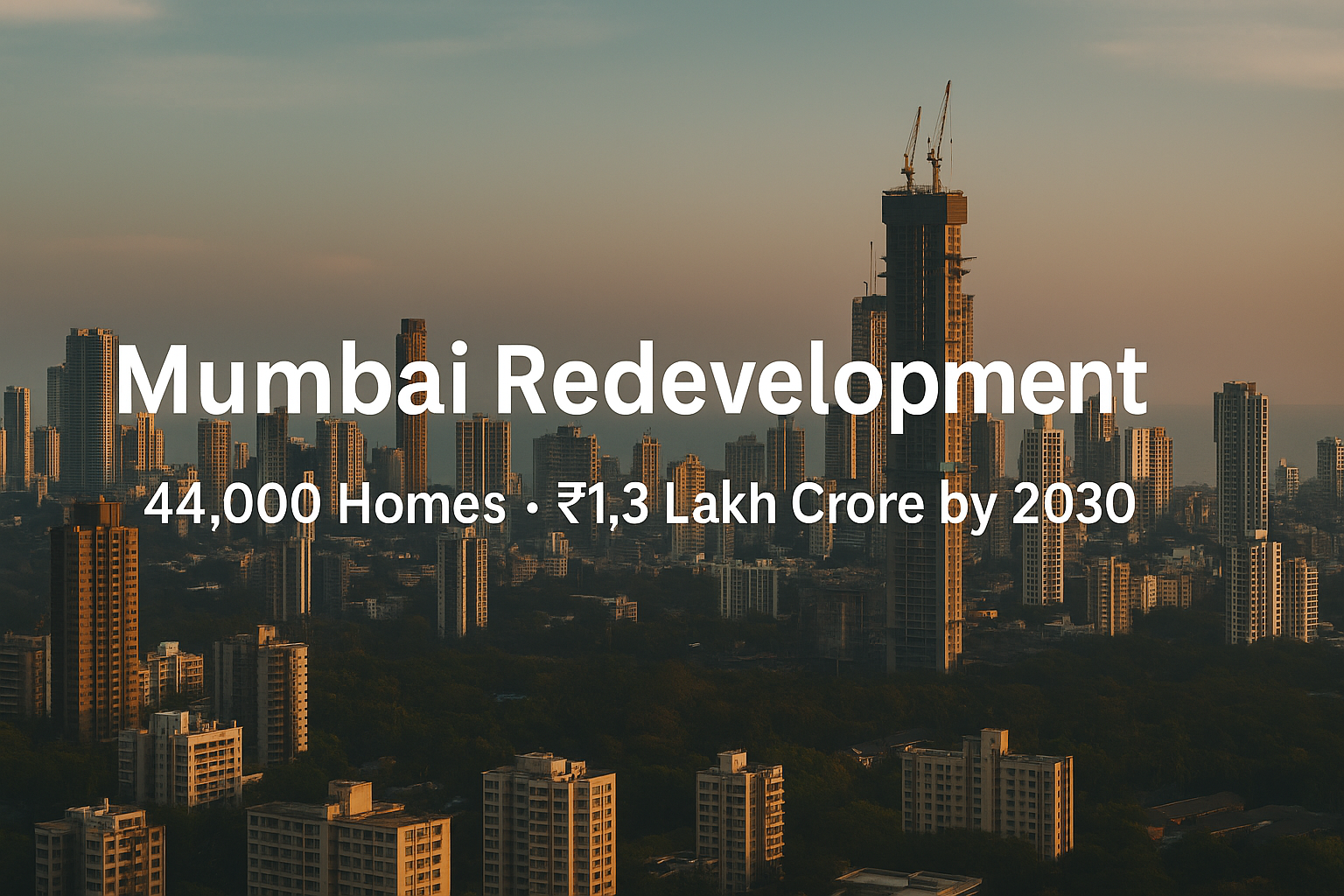Walk around Mumbai today and you’ll notice a familiar sight: old societies covered in blue tin sheets, waiting to be torn down and replaced by glass towers. This is redevelopment in motion and according to a recent Knight Frank India report, it’s going to reshape the city’s housing supply in the coming decade.
By 2030, redevelopment projects in Mumbai are expected to deliver 44,277 new homes with a combined market value of ₹1.3 lakh crore. Along the way, the state exchequer could earn more than ₹14,000 crore in stamp duty and GST from the free-sale portion of these projects.
Why Redevelopment Has Become Inevitable
Mumbai has little to no greenfield land left for large-scale housing projects. The city’s future supply will come largely from rebuilding what already exists.
- Ageing Housing Stock: Over 1.6 lakh housing societies in Mumbai are older than 30 years. Many are reaching the end of their structural lives.
- Demand-Supply Mismatch: With the population growing and prices consistently high, there’s strong demand for new, better-quality housing in the same neighbourhoods.
- Policy Support: Regulations like DCPR 2034 have given clearer guidelines and incentives for redevelopment, which is making projects more viable for developers.
For homeowners, redevelopment provides a chance to swap old flats for brand-new ones with modern amenities. For developers, it offers land in locations that would otherwise be impossible to build on. For the government, it creates steady tax revenues.
The Scale of the Opportunity
Knight Frank’s projections underline just how big this market is:
- 44,277 new homes will be added through redevelopment by 2030.
- The total value of this supply is pegged at ₹1.3 lakh crore.
- The free-sale component alone is expected to contribute ₹7,830 crore in stamp duty and ₹6,525 crore in GST.
Western Suburbs Take the Lead
Not all parts of Mumbai are equally active in redevelopment. While South Mumbai continues to see luxury-focused projects, the Western Suburbs dominate by sheer scale.
- Nearly 73% of all new homes under redevelopment will come from this belt.
- Micro-markets like Bandra, Andheri, and Borivali lead the activity.
Why the Western Suburbs?
- High density means more old societies eligible for redevelopment.
- Strong demand from middle-class and upper-middle-class buyers ensures absorption.
- Better project economics compared to South Mumbai, where land and compensation costs often make projects unviable.
In contrast, Central and South Mumbai face hurdles such as fragmented ownership, legacy tenancy rights, and very high costs, which is making large-scale redevelopment slower and more complex.
The Timeline Challenge
If redevelopment sounds like a goldmine to you, it’s important to understand the timelines involved.
- Most projects take 8-11 years from signing the first Development Agreement (DA) to handing over completed apartments.
- Societies that began the process in 2020 are still at early construction or delivery stages today.
That long gestation period exposes projects to multiple risks like changes in interest rates, construction costs, policies and even buyer sentiment. Developers need deep pockets and resilience to survive the cycle.
Risks and Roadblocks
The Knight Frank report also highlights the challenges that societies and developers must overcome:
- Consensus BuildingEvery society member must agree. A single dissenting voice can delay progress by years.
- Title and Legal ClarityMany older societies have unclear ownership, missing documents or tenancy disputes that complicate redevelopment.
- Financial ViabilityRising land and construction costs mean developers must carefully balance the share of area given to society members versus the free-sale portion. Over-promising can sink a project.
- Regulatory ApprovalsCivic clearances and compliance with planning norms often take months, if not years. Any delay eats into margins and timelines.
What This Means for Homeowners
For a homeowner in an ageing society, redevelopment is both an opportunity and a challenge.
The positives:
- A brand-new flat with better safety standards, layouts and amenities.
- An appreciating asset instead of a depreciating one.
- Relief from constant repairs and maintenance costs.
The trade-offs:
- Years of living in rented transit accommodation while waiting for the project to complete.
- The need to carefully evaluate the developer’s track record before signing.
- Limited control once the agreement is in place, timelines can slip.
What This Means for Buyers
For homebuyers, redevelopment projects represent a way to access prime locations that have no vacant land left.
The upside:
- New housing stock in established neighbourhoods with existing infrastructure.
- Strong long-term appreciation potential due to limited supply.
The risk:
- Delays are common. Buyers must check RERA registrations, track record, and developer credibility before investing.
What This Means For Developers
For developers, the numbers are attractive but execution is everything.
- Redevelopment requires long-term capital and patience.
- It demands financial discipline, balancing society expectations with project viability.
- It also offers a strategic edge: fresh inventory in locations where no new land is available.
Those who manage costs, timelines and transparency will be the ones to win big in this cycle.
Final Words
Mumbai has always found ways to reinvent itself, from mills turning into offices to metros changing commutes. The next reinvention will come from within its old housing societies.
Redevelopment is messy, slow and complex. But it’s also the only scalable way to create new homes in India’s most space-starved city.
The Knight Frank report projects 44,000+ homes worth ₹1.3 lakh crore by 2030. If delivered, this won’t just be a housing supply boost but will also be one of the most significant urban renewal stories in India’s real estate history.








